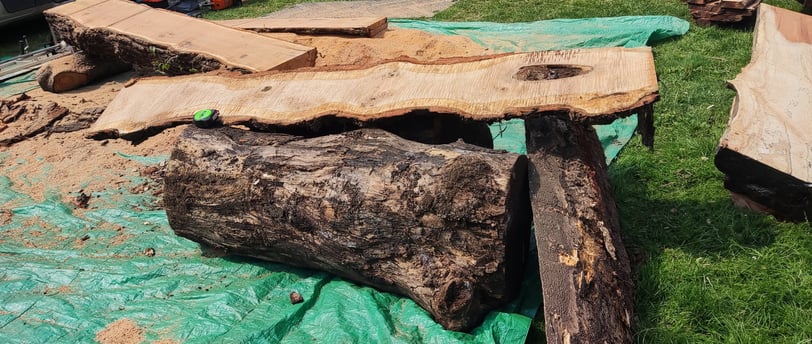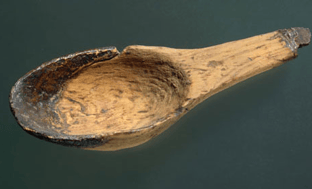Green wood, why Not?
Discover what green wood is, its applications, and how it compares to seasoned wood. Learn about the characteristics of green wood and when it's best to use in your projects.
7/9/20245 min read


When we started on the Chiswick House project I was so excited to get started I didn't really think much about the material. My mind went straight to the creative elements the form, the live edge, the story of the wood, the connections to nature. I really wasn't paying much attention to Marks logical mind, his practical functional side. To me the mention of green wood did not mean very much. Why was he concerned? How bad could Green wood be?
Mark educated me and introduced me to the term "seasoned wood." which is basically the process of drying wood out. Mark is a master carpenter with over 27 yrs experience so I knew he knew what he was talking about but I couldn't help but question it (it's what I always do!)
He explained that freshly cut wood, often called green wood, contains a lot of water. Depending on the type of tree, green wood can be anywhere from 30% to 60% water by weight! That’s a lot of moisture. Over time, if you let the wood air out or dry it using heat, the water evaporates, and the wood becomes stronger, lighter, and less likely to warp or rot. That all made sense but I couldn't help but think, has wood always been Seasoned before humans used it? Would ancient people really of had the time to wait 2 years before building their house or making their canoe. I did what I love doing as much as creating, some research, and the short answer is: No, not always!
Here's what I found out about green wood, seasoning wood, why it matters, and how humans have used wood throughout history—sometimes seasoned, sometimes not.






Photograph of the Shigir sculpture reconstructed by D. Lobanov (1890–1891), on display in this shape until 1914 (after Heikel Reference Heikel1894) Cambridge university press
The Shigir Idol, which is considered the world's oldest wooden sculpture, is on display at the Sverdlovsk Regional Museum of Local Lore in Russia. (Image credit: Donat Sorokin/TASS via Getty Images)


The wooden spoon from the bog Christiansholms Mose in northern Zealand is very well preserved.
So, Has Wood Always Been Seasoned?
No! Humans have been using green wood for thousands of years, and it worked fine for many purposes. But as our needs evolved, so did our understanding of how to make wood last longer and work better for construction, furniture, and other uses. Today, we season wood to make sure it’s strong, durable, and stable, but green wood still has its place in the world of art and craft.
Whether it’s seasoned or green, wood has been an essential part of human life for millennia. Now, with modern technology and knowledge, we’re able to make the most of this incredible natural resource—no matter how we use it!
I am really looking forward to this creative journey and although Mark is sceptical, as this will be his first experience of green wood on such a large scale he loves a challenge and the learning that will come with it. We look forward to sharing the progress.
Ancient Human Use of Wood: Green and Ready to Go!
Ancient humans used green wood all the time. Early civilizations were not waiting around for their wood to dry out for months (or years). They needed to build shelters, tools, and weapons right then and there from local trees. It wasn’t perfect, but it was available! When carving spears or making simple tools, people often worked with green wood because it was easier to cut and shape, this was an advantage in the construction of things like bows, boats, and even furniture where flexibility was important also seasoning wasn’t a priority when survival was the main focus.
The Shift to Seasoned Wood
As human societies became more advanced, when larger, more permanent buildings and structures were needed, people started to notice that seasoned wood was stronger, more durable, and less prone to rotting. The importance of using properly seasoned wood becomes clear. The seasoning of wood is evident as far back as Ancient Egyptians. The Egyptians, known for their craftsmanship and knowledge of materials, would have understood the advantages of using well-seasoned wood for creating long-lasting structures and artefacts including the constructing temples, ships, furniture, and coffins, like the ones found in royal tombs. By the Middle Ages, seasoned wood became the standard for constructing large wooden beams used in homes, barns, and cathedrals. Seasoning reduced the chances of the wood warping or cracking after construction.
Why Seasoning Became Essential
1. Durability Seasoned wood lasts longer. By drying the wood, the risk of rot, mould, and insect infestations is much lower. This is especially important in buildings or tools that needed to last for years or even decades
2. Strength As wood dries, it becomes harder and more rigid. This made it perfect for constructing things like bridges, ships, and homes. Stronger wood meant less maintenance and more safety.
3. Stability When green wood dries, it shrinks, and sometimes it warps or cracks. Imagine building a house out of green wood, only to have the walls start to twist and buckle as the wood dried! Using seasoned wood helped avoid these issues, ensuring that the structures stayed solid over time.
Modern Times: Seasoning as a Standard Practice
Today, almost all the wood we use for furniture, buildings, and other projects is seasoned. You’ll rarely come across green wood unless you’re working on a specific craft project or something like traditional green woodworking, where the flexibility of fresh wood is an asset.
There are two main methods of seasoning wood today:
1. Air-Drying: This is the old-fashioned way of letting wood dry naturally. It can take months or even years, depending on the size of the wood and the climate.
2. Kiln-Drying: This modern method uses heat to quickly remove moisture from the wood. It’s much faster than air-drying and allows for more control over the process, which means fewer defects like cracking or warping.
Green Wood in Creative Arts and Crafts
While seasoned wood is the go-to choice for most construction today, green wood is still used by artisans and craftsmen for specific projects. In green woodworking, for example, people use fresh-cut wood to create furniture, utensils, and even sculptures. Green wood is easier to carve and bend, making it ideal for certain types of woodworking where flexibility is key.


Nature, Artistry, Sustainability
Transforming nature into beautiful, functional creations.
Harvesting Connections
ayeshaweekes@gmail.com
07958487488
© 2024. All rights reserved.
